[ENG]Buildings of the Plaza de Bolívar in Bogotá - COLOMBIA [ESP]Edificaciones de la Plaza de Bolívar de Bogotá – COLOMBIA
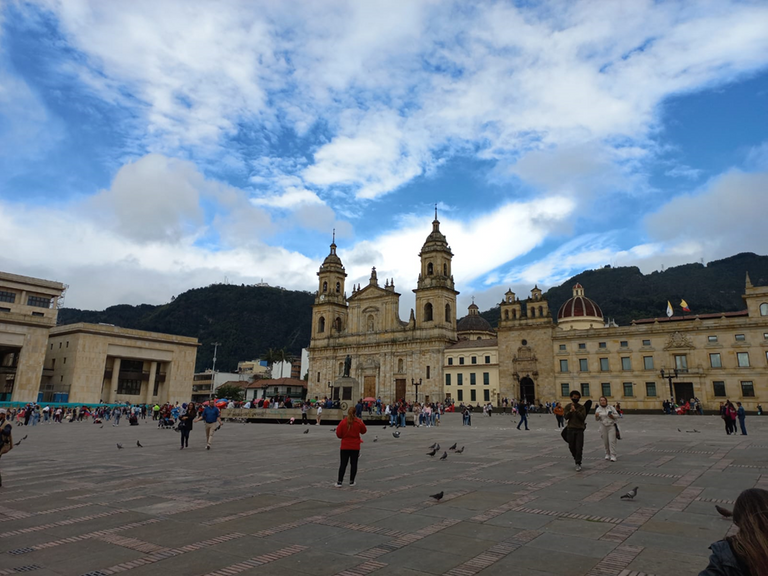
Bogotá, the capital of Colombia, is a city of about 8 million inhabitants, located in the north of South America, it covers an area of 183 hectares and is 2640 meters above sea level, so its climate is delicious. Today we will dedicate ourselves to taking a virtual walk through the Plaza de Bolívar that includes buildings of great architectural and historical interest. The photos that make up this post are of my brother-in-law Alfonso Celi, taken on one of his last visits to the capital of New Granada, and of my colleague and friend, professor Luz Marina Rivas, who lives in Bogotá. My thanks to both of them for their support.
Bogotá, capital de Colombia, es una ciudad de unos 8 millones de habitantes, ubicada al norte de Sud-América, cubre una superficie de 183 hectáreas y está a 2640 metros sobre el nivel del mar, por lo que su clima es delicioso. Hoy nos dedicaremos a dar un paseo virtual por la Plaza de Bolívar que incluye edificaciones de gran interés arquitectónico e histórico. Las fotos que nutren este post son de mi cuñado Alfonso Celi, tomadas en una de sus últimas visitas a la capital neogranadina, y de la colega y amiga, la profesora Luz Marina Rivas, quien vive en Bogotá. Para ambos mi agradecimiento por su apoyo.
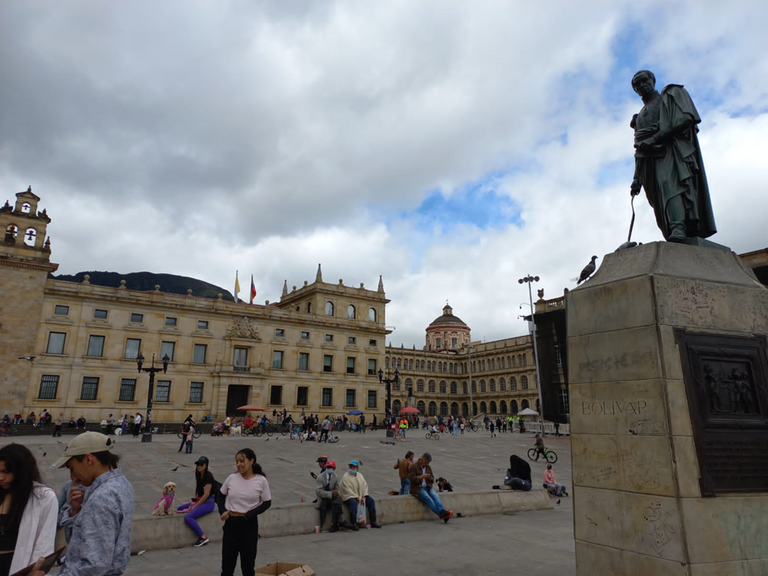
La Candelaria is the historic center of Bogotá, the capital of Colombia, located in the center-east of the city with iconic places such as the colonial Cathedral and the neoclassical Capitol that surround Plaza Bolívar. This part of the city is characterized by its large mansions and its narrow-cobbled streets, reminiscent of what the city once was, now full of shops that sell emeralds and handicrafts, but also lead to cultural places, such as the Gold Museum, with pre-Columbian artifacts and the Botero Museum, which exhibits international art in a colonial mansion. Spending a day in this part of the city can be combined with a good plate of typical food, such as ajiaco, in one of the many exotic and informal restaurants that abound there.
La Candelaria es el centro histórico de Bogotá, capital de Colombia, ubicada en el centro-oriente de la ciudad con lugares icónicos como la Catedral colonial y el Capitolio neoclásico que circundan la Plaza Bolívar. Esta parte de la ciudad se caracteriza por sus grandes casonas y sus calles estrechas adoquinadas, reminiscencia de lo que antiguamente era la ciudad, ahora llenas de tiendas que comercian esmeraldas y artesanías, pero que también conducen a lugares culturales, como el Museo del Oro, con artefactos precolombinos y el Museo Botero, que exhibe arte internacional en una mansión colonial. Pasar un día en esta parte de la ciudad puede combinarse con un buen plato de comida típica, como el ajiaco, en uno de los múltiples restaurantes exóticos e informales que pululan allí.
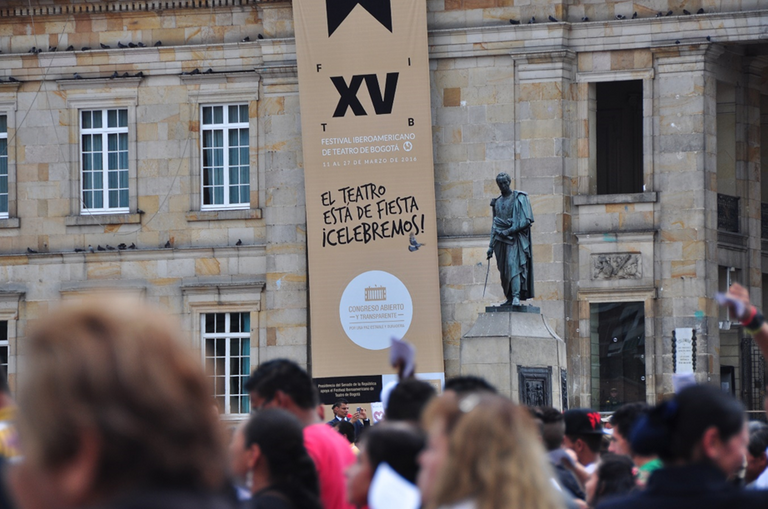
The Plaza de Bolívar, named after the father of the country, the Venezuelan Simón Bolívar, has an area of approximately 14,000 square meters (150,000 square feet) and a standing capacity of more than 55,000 people, around which there are several buildings of varied architectural styles, such as the Metropolitan Cathedral Basilica of the Immaculate Conception, the building of the Congress of the Republic, the Renaissance Liévano palace or mayor of Bogotá, the house del Florero, the San Bartolomeo school and the renovated and modern Palace of Justice. The Plaza was declared a National Monument in 1995.
La Plaza de Bolívar, llamada así en homenaje al padre de la patria, el venezolano Simón Bolívar, tiene una superficie de aproximadamente 14.000 metros cuadrados (150.000 pies cuadrados) y una capacidad para albergar de pie a más de 55.000 personas, alrededor de la cual se encuentran diversos edificios de variados estilos arquitectónicos, como la Catedral Basílica Metropolitana de la Inmaculada Concepción, el edificio del Congreso de la República, el palacio renacentista Liévano o alcaldía de Bogotá, la casa del Florero, el colegio San Bartolomeo y el renovado y moderno Palacio de Justicia. La Plaza fue declarada Monumento Nacional en 1995.
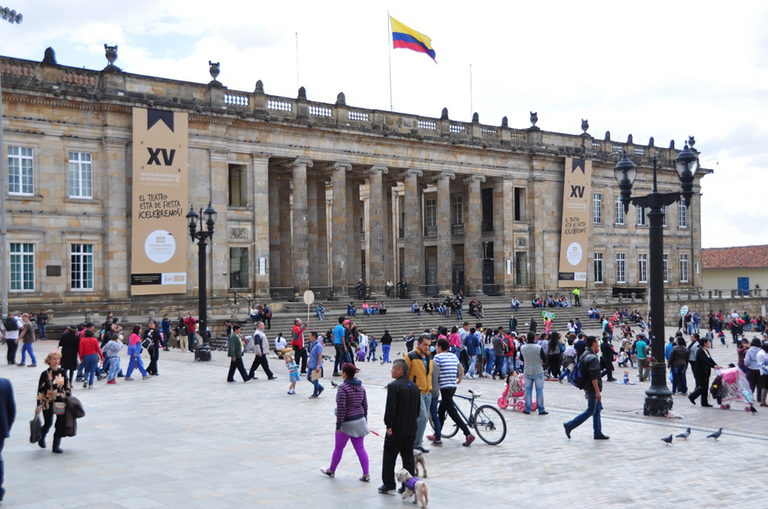
Its construction began in 1538 by the Spanish crown and was called Plaza Mayor, throughout history it has undergone several modifications that have changed its architectural and design style, and even its use. By 1600 a water source was placed that supplied the population. Once the liberation from the Spanish Crown was achieved, in 1821, its name was changed to Plaza de la Constitución and between 1842 and 45 the building of the Congress of the Republic was built, and in the center of the square, the Statue of the Liberator, made in bronze by the Italian sculptor Pietro Tenerani, at which time it was given the name by which we know it today: Plaza de Bolívar. In the last century it underwent new modifications and was given a strictly pedestrian use. For more information, see: https://bogota.gov.co/mi-ciudad/cultura-recreacion-y-deporte/lo-que-tu-no-sabias-de-la-plaza-de-bolivar-de- Bogota.
Su construcción se inició en 1538 por parte de la corona española y se le llamó Plaza Mayor, a lo largo de la historia ha sufrido varias modificaciones que han cambiado su estilo arquitectónico y de diseño, e incluso de uso. Para 1600 se colocó una fuente de agua que abastecía a la población. Una vez alcanzada la liberación de la Corona española, en 1821, se le cambió el nombre para Plaza de la Constitución y entre 1842 y 45 se construyó el edificio del Congreso de la República, y se inauguró, en el centro de la plaza, la estatua del Libertador, hecha en bronce por el escultor italiano Pietro Tenerani, momento en el cual se le puso el nombre con el que la conocemos actualmente: Plaza de Bolívar. En el siglo pasado sufrió nuevas modificaciones y se le dio un uso estrictamente peatonal. Para mayor información, puede consultarse https: //bogota.gov.co/mi-ciudad/cultura-recreacion-y-deporte/lo-que-tu-no-sabias-de-la-plaza-de-bolivar-de-bogota.
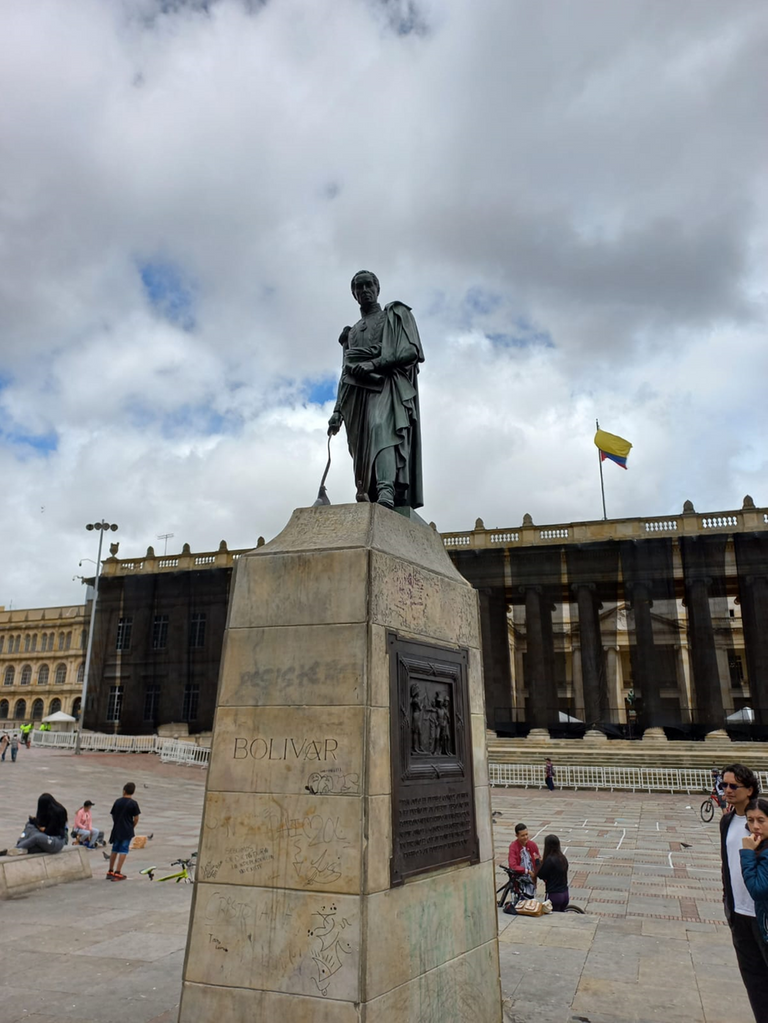
The Federal Legislative Palace, or Capitol, the seat of the Colombian Congress, was built between the 19th and 20th centuries. The Danish architect Thomas Reed was hired by the government to carry out the project and subsequent construction, although almost a dozen architects had to do with the construction of the building that took 80 years to complete. According to experts, the style of the Palace is an eclectic mix of architectural influences, such as Ionic, Neoclassical, and Renaissance. The blond stone that was used in its construction was taken from quarries near Bogotá.
El Palacio Federal Legislativo, o Capitolio, sede del Congreso colombiano, construido entre los siglos XIX y XX. El arquitecto danés Thomas Reed fue contratado por el gobierno para la realización del proyecto y posterior construcción, aunque casi una decena de arquitectos tuvieron que ver con la construcción de la edificación que se tardó 80 años para su culminación. Según los expertos, el estilo del Palacio es una mezcla ecléctica de influencias arquitectónicas, tales como el jónico, neoclásico y renacentista. La piedra rubia que se utilizó en su construcción fue sacada de unas canteras cercanas a Bogotá.
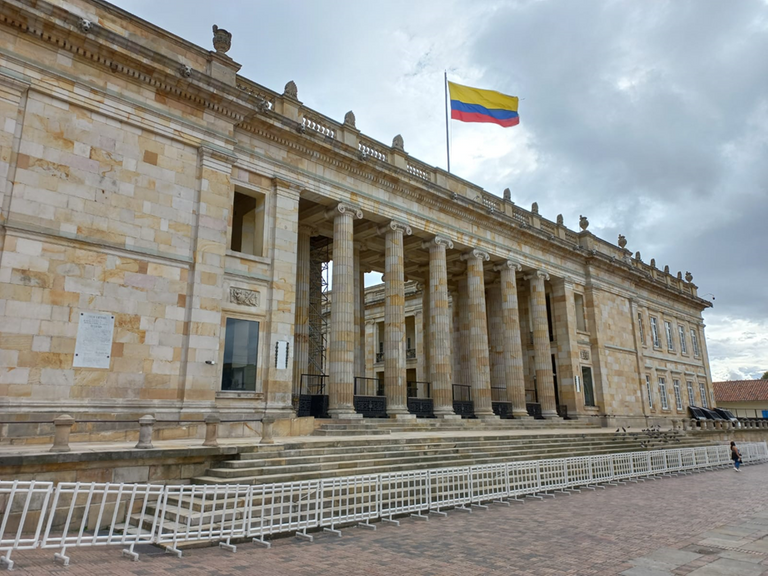
During the restoration, carried out in 1997, remains of colonial constructions were found, which is why the area, in which the building is built, has been classified as an archaeological zone. In addition, in 1975 this first civil work built in Colombia was declared a National Monument.
Durante la restauración, realizada en 1997, se encontraron restos de construcciones coloniales, razón por la cual el área, en la que está levantada la edificación, ha sido catalogada como zona arqueológica. Además, en 1975 esta primera obra civil construida en Colombia, fue declarada Monumento Nacional.
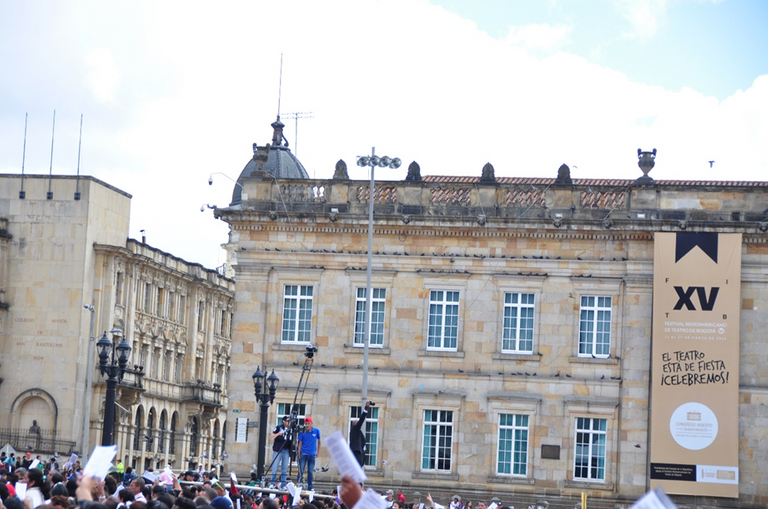
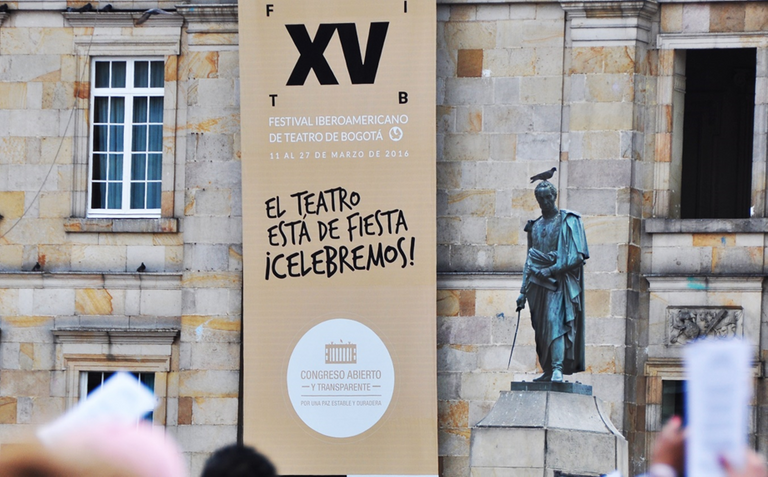
Museum of Independence or “Casa del Florero”, is located in the northeast corner of the Plaza, next to the Cathedral, built at the end of the 16th century in an Arab-Andalusian or Mudejar style, characteristic of Colombian colonial constructions. It became famous for being the scene of the Cry of Independence in July 1810, it houses the exhibition of personal belongings of the Liberator Simón Bolívar and other heroes of Colombian emancipation, documents of General Santander, there is also a collection of Constitutions of Colombia and a copy of the Declaration of Independence. It has undergone extensions and remodeling, the last of which was carried out by the architect González Varona.
Museo de la Independencia o Casa del Florero, se encuentra en la esquina noreste de la Plaza, a un costado de la Catedral, construida a finales del siglo XVI en un estilo árabe-andaluz o mudéjar, característico de las construcciones coloniales colombianas. Se hizo famosa por ser escenario del Grito de Independencia en julio de 1810, guarda en su seno la exhibición de objetos personales del Libertador Simón Bolívar y otros héroes de la emancipación colombiana, documentos del general Santander, se encuentra también una colección de Constituciones de Colombia y una copia dl Acta de la Independencia. Ha sufrido ampliaciones y remodelaciones, la última de ellas realizada por el arquitecto González Varona.
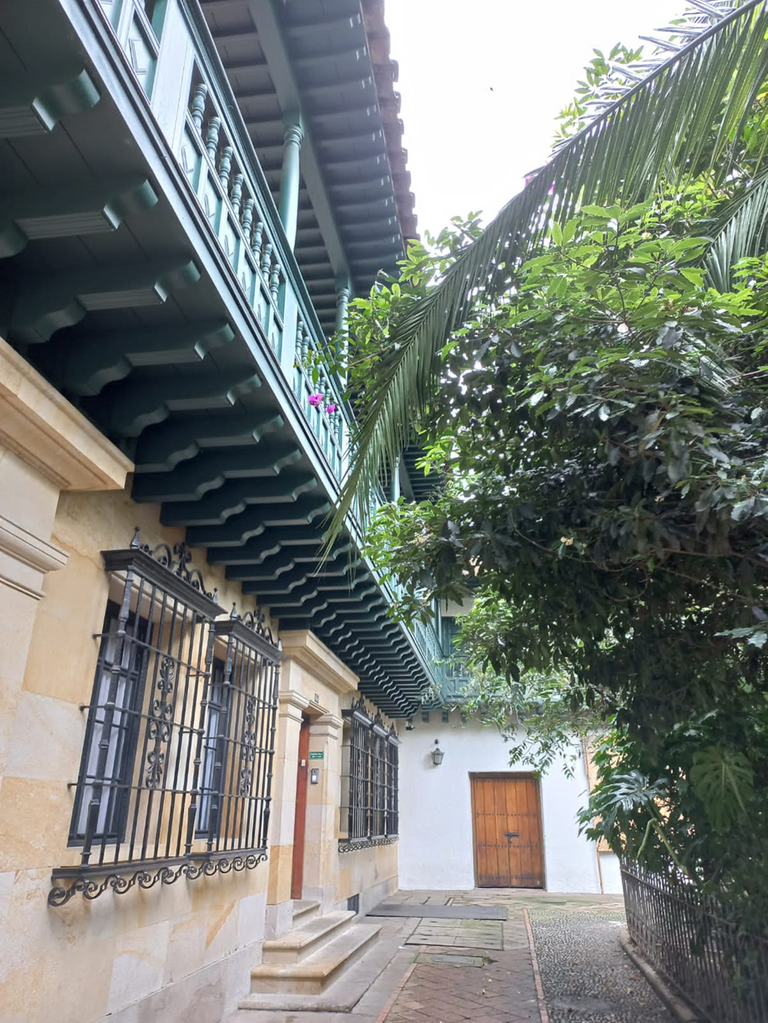
Jesuit College of San Bartolomé, for more than 400 years is the oldest in Colombia; Its high school campus is located in the Plaza de Bolívar since 1975, diagonally to the southeast corner, it has been declared a Site of Cultural Interest and a National Monument of the Country. It was designed by the architect Juan Bautista Coluccini in a colonial style and underwent later modifications and extensions. The current building consists of a small square, patios with arcades and Spanish tiled roofs, a dome, a tower, and the tower of the flag.
Colegio mayor jesuítico de San Bartolomé, desde hace más de 400 años, es el más antiguo de Colombia; su sede de bachillerato está ubicada en la Plaza de Bolívar desde 1975, en diagonal a la esquina suroriental, ha sido decretado Bien de interés Cultural y Monumento Nacional del País. Fue diseñado por el arquitecto Juan Bautista Coluccini en estilo colonial y sufrió modificaciones y ampliaciones posteriores. El edificio actual consta de una plazoleta, patios con arcadas y techos de tejas españolas, una cúpula, torre y el torreón de la bandera.
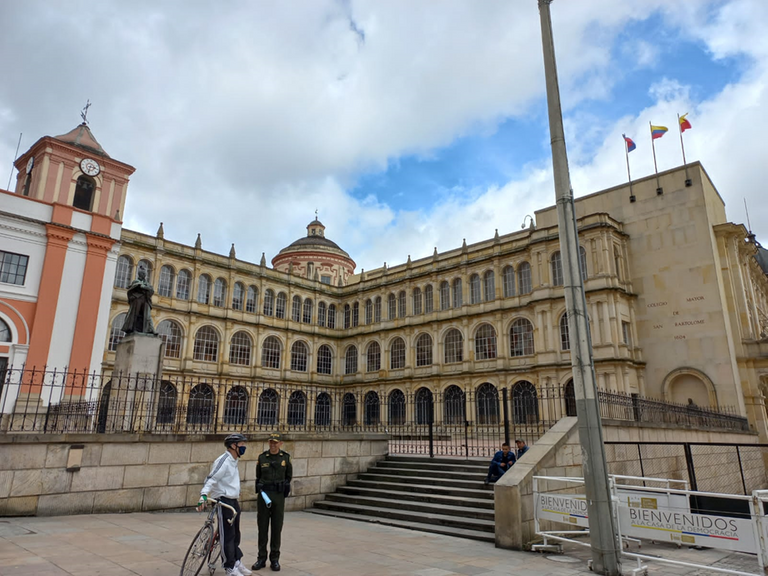
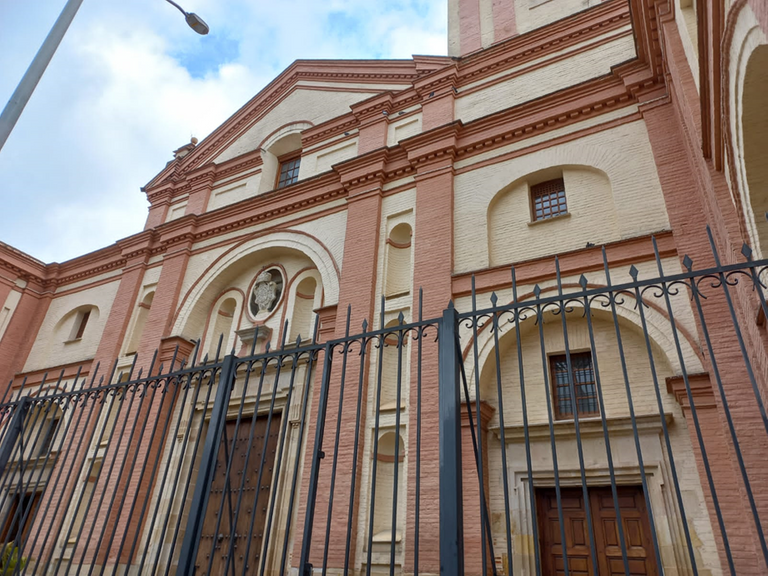
The Primate Cathedral of the Immaculate Conception is located in the Plaza de Bolívar. The current building was built in 1823 after three previous buildings, with a Doric style facade and Ionic design towers, its interior is made up of a central nave and two side naves of the same height, the main altar, and 14 chapels.
La Catedral Primada de la Inmaculada Concepción está ubicada en la Plaza de Bolívar. El edificio actual fue construido en 1823 después de tres edificios anteriores, con una fachada de estilo dórico y con torres de diseño jónico, su interior está conformado por una nave central y dos laterales de la misma altura, el altar mayor y 14 capillas.

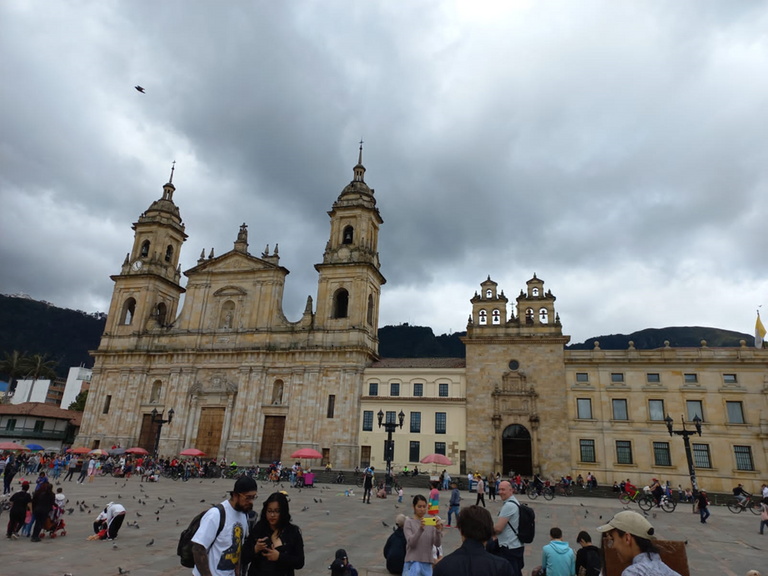
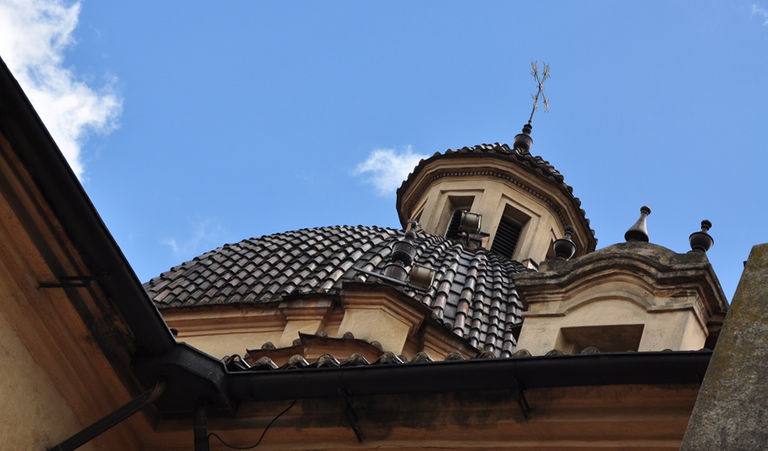
The Liévano Palace in Bogotá is another of the great works located in Plaza Bolívar, on the western side of it, in this palace, the Mayor's Office of Bogotá functions. The work was completed in 1848, its construction was carried out by the Arrubla brothers, who placed the current arcaded façade. In 1900 the building, which was ultimately a shopping center, suffered a fire that devastated its structure. Historians point out that the engineer Liévano took the initiative to rebuild it, for which the French architect Gastón Lelarge was hired, who respected the façade of the previous building, but in a style called “French Renaissance”. Only 60 years after this episode, the Municipality acquired the building and underwent a general restoration to adapt it as the seat of the Mayor's Office of Bogotá.
El Palacio Liévano de Bogotá es otra de las grandes obras situadas en la Plaza Bolívar, en el costado occidental de la misma, en este palacio función la ALCALDÍA Mayor de Bogotá. La obra fue terminada en 1848, su construcción la realizaron los hermanos Arrubla, quienes le colocaron la actual fachada aporticada. En 1900 el edificio, que a la postre era un centro comercial, sufrió un incendio que devastó su estructura. Señalan los historiadores que el ingeniero Liévano tomó la iniciativa de reconstruirlo, para lo cual se contrató al arquitecto francés Gastón Lelarge, quien respetó la fachada del anterior edificio, pero en un estilo denominado “Renacimiento Francés”. Solo después de 60 años de este episodio, el Municipio adquirió el edificio y fue sujeto de una restauración general para adecuarlo como sede de la Alcaldía Mayor de Bogotá.
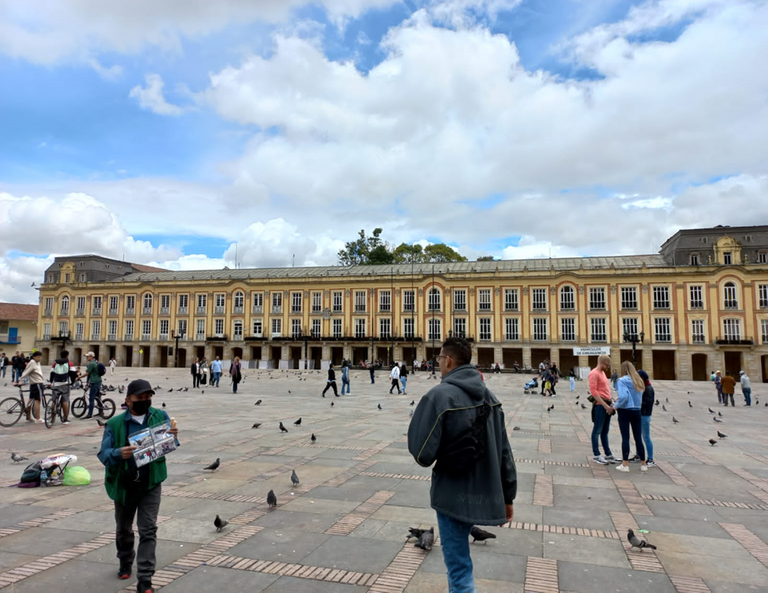
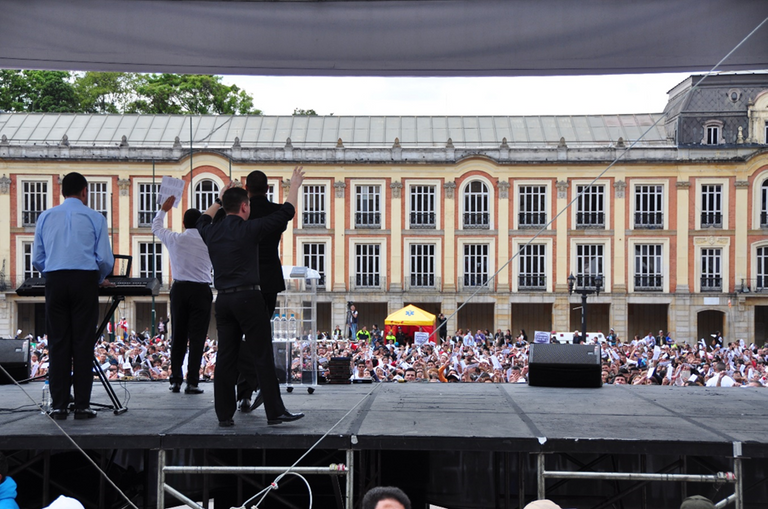
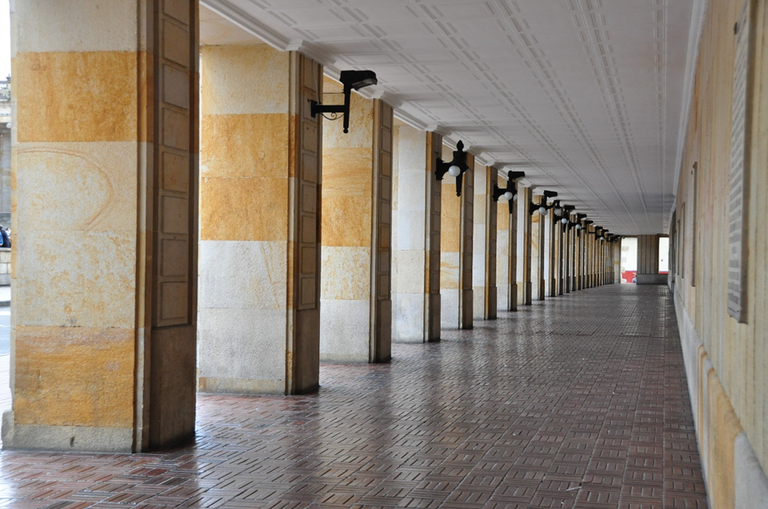
In contrast to the rest of the buildings in Plaza Bolívar, we find a modern building that houses the Palace of Justice. It is a work of recent date that breaks out as a discordance with the other heritage works erected in the Plaza de Bolívar. This building is the third to be built to be the seat of the judiciary, the first two suffered the consequences of a politically divided country, with armed groups willing to give everything for everything to conquer power. The current building was built by the architect Roberto Londoño and emerged after the tragedy that occurred in 1985. Inaugurated in 2004, it was baptized as the Supreme Court of Justice “Alfonso Reyes Echandía” in homage to the president of the court, who died in the taking of 1985. The Palace has all the characteristics of a well-guarded building, with maximum electronic security, bulletproof windows, and a reinforced concrete structure. It consists of two symmetrical bodies of four stories high each.
En contraste con el resto de las edificaciones de la Plaza Bolívar, encontramos un moderno edificio sede del Palacio de justicia. Es una obra de data reciente que irrumpe como discordancia con las otras obras patrimoniales levantadas en la Plaza de Bolívar. Este edificio es el tercero que se construye para ser sede del poder judicial, los dos primeros sufrieron las consecuencias de un país dividido políticamente, con grupos armados dispuestos a dar el todo por el todo para conquistar el poder. El actual edificio fue construido por el arquitecto Roberto Londoño y surgió luego de la tragedia acaecida en 1985, inaugurado en 2004 fue bautizado como Corte Suprema de Justicia “Alfonso Reyes Echandía” en homenaje al presidente de la corte, muerto en la toma del 85. El Palacio tiene todas las características de un edificio de bien resguardado, con máxima seguridad electrónica, ventanas a prueba de balas, estructura en concreto armado. Consta de dos cuerpos simétricos de cuatro pisos de altura cada uno.
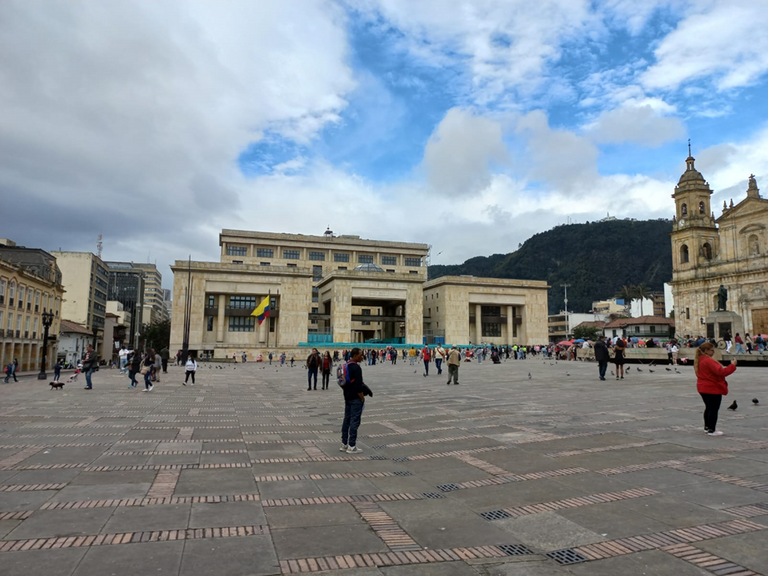

The historical and architectural data were taken from the following bibliographic sources (Los datos históricos y arquitectónicos fueron tomados de las siguientes fuentes bibliográficas):
- https://bogota.gov.co/mi-ciudad/cultura-recreacion-y-deporte/lo-que-tu-no-sabias-de-la-plaza-de-bolivar-de-bogota.
- https://www.culturarecreacionydeporte.gov.co/es/bogotanitos/bogodatos/palacio-lievano
*https://www.academia.edu/5949645/Nuevo_palacio_de_Justicia_de_Bogot%C3%A1_La_arquitectura_como_m%C3%A1scara - https://www.radionacional.co/cultura/historia-colombiana/trece-curiosidades-que-debe-saber-sobre-el-capitolio-nacional
Congratulations, your post has been added to Pinmapple! 🎉🥳🍍
Did you know you have your own profile map?
And every post has their own map too!
Want to have your post on the map too?
Thank you very much dear friends of Pinmapple.
Dear @besamu,
May I ask you to review and support the new HiveSQL Proposal so we can keep it free to use for the community?
You can do it on Peakd, ecency, Hive.blog or using HiveSigner
Thank you!
Dear @besamu,
Your support for the current HiveBuzz proposal (#199) is much appreciated but the proposal will expire soon!
May we ask you to review and support the new proposal so our team can continue its work?
You can support the new proposal (#248) on Peakd, Ecency, Hive.blog or using HiveSigner.
Thank you!
Congratulations @besamu! You received a personal badge!
You can view your badges on your board and compare yourself to others in the Ranking
Check out our last posts:
Support the HiveBuzz project. Vote for our proposal!